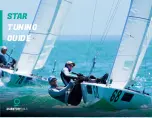
22
(c)
Through the tack eye
travelling in a port/left to
starboard/right direction.
(d)
Downward and through the
plastic fairlead on the
underside of the inboard end
of the boom travelling in a
starboard/right to port/left
direction
(e)
Upward and for the second time,
through the tack eye travelling in a
port/left to starboard/right
direction.
(f)
Downward and through the lug on
the starboard side of the inboard
boom end yoke arm
(g)
Downward and through the clam
cleat on the starboard side of the
mast immediately below the
gooseneck collar.
(h)
Downward and through the pulley
block immediately below the
aforementioned clam cleat before
tieing a 100mm rope handle in the
end of the control line.
Note:
This ensures the mast is NOT able to
“free
rotate
” thus keeping the bent topmast in
parallel with the boom to maintain the best
sail flying shape possible.
Summary of Contents for BUG
Page 1: ......
Page 6: ...6 3 Parts of the Bug Specification Tack of sail Foot of sail Centreboard...
Page 9: ...9...
Page 10: ...10...





































